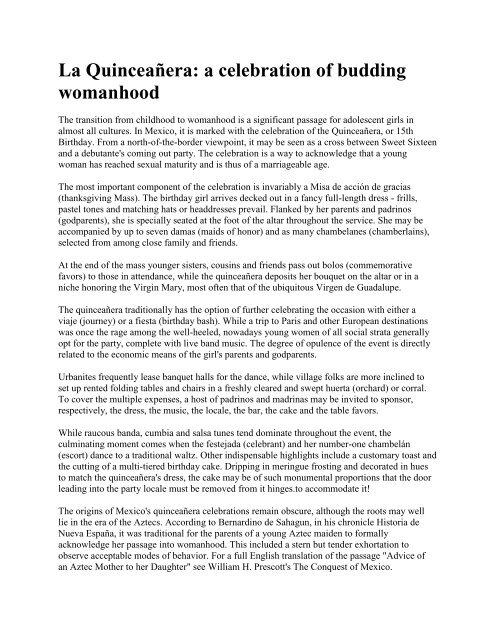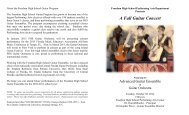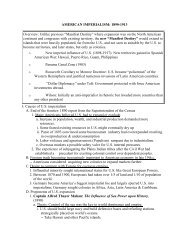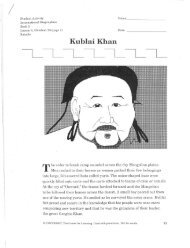Vocabulario para celebrar Activity - OCPS Teacher Server
Vocabulario para celebrar Activity - OCPS Teacher Server
Vocabulario para celebrar Activity - OCPS Teacher Server
Create successful ePaper yourself
Turn your PDF publications into a flip-book with our unique Google optimized e-Paper software.
La Quinceañera: a celebration of budding<br />
womanhood<br />
The transition from childhood to womanhood is a significant passage for adolescent girls in<br />
almost all cultures. In Mexico, it is marked with the celebration of the Quinceañera, or 15th<br />
Birthday. From a north-of-the-border viewpoint, it may be seen as a cross between Sweet Sixteen<br />
and a debutante's coming out party. The celebration is a way to acknowledge that a young<br />
woman has reached sexual maturity and is thus of a marriageable age.<br />
The most important component of the celebration is invariably a Misa de acción de gracias<br />
(thanksgiving Mass). The birthday girl arrives decked out in a fancy full-length dress - frills,<br />
pastel tones and matching hats or headdresses prevail. Flanked by her parents and padrinos<br />
(godparents), she is specially seated at the foot of the altar throughout the service. She may be<br />
accompanied by up to seven damas (maids of honor) and as many chambelanes (chamberlains),<br />
selected from among close family and friends.<br />
At the end of the mass younger sisters, cousins and friends pass out bolos (commemorative<br />
favors) to those in attendance, while the quinceañera deposits her bouquet on the altar or in a<br />
niche honoring the Virgin Mary, most often that of the ubiquitous Virgen de Guadalupe.<br />
The quinceañera traditionally has the option of further celebrating the occasion with either a<br />
viaje (journey) or a fiesta (birthday bash). While a trip to Paris and other European destinations<br />
was once the rage among the well-heeled, nowadays young women of all social strata generally<br />
opt for the party, complete with live band music. The degree of opulence of the event is directly<br />
related to the economic means of the girl's parents and godparents.<br />
Urbanites frequently lease banquet halls for the dance, while village folks are more inclined to<br />
set up rented folding tables and chairs in a freshly cleared and swept huerta (orchard) or corral.<br />
To cover the multiple expenses, a host of padrinos and madrinas may be invited to sponsor,<br />
respectively, the dress, the music, the locale, the bar, the cake and the table favors.<br />
While raucous banda, cumbia and salsa tunes tend dominate throughout the event, the<br />
culminating moment comes when the festejada (celebrant) and her number-one chambelán<br />
(escort) dance to a traditional waltz. Other indispensable highlights include a customary toast and<br />
the cutting of a multi-tiered birthday cake. Dripping in meringue frosting and decorated in hues<br />
to match the quinceañera's dress, the cake may be of such monumental proportions that the door<br />
leading into the party locale must be removed from it hinges.to accommodate it!<br />
The origins of Mexico's quinceañera celebrations remain obscure, although the roots may well<br />
lie in the era of the Aztecs. According to Bernardino de Sahagun, in his chronicle Historia de<br />
Nueva España, it was traditional for the parents of a young Aztec maiden to formally<br />
acknowledge her passage into womanhood. This included a stern but tender exhortation to<br />
observe acceptable modes of behavior. For a full English translation of the passage "Advice of<br />
an Aztec Mother to her Daughter" see William H. Prescott's The Conquest of Mexico.
















